Page 2 of 2
Posted: Mon Nov 03, 2014 11:40
by spud
Hey Crusty
A couple of quick questions about your thick Biltong, is there thin and thick? What is normal?
What are approx. dimensions you are cutting to.
Don't know where I read it but Jerky is cut from meat cut with the grain then cut across the grain once finished?
Lovely pic by the way as well.

rgds Spud
Posted: Mon Nov 03, 2014 13:29
by Janlab
Spud, I actually make the "big" biltong. I use a whole sirloin roast. Normally biltong would not be cut more than 30 mm thick ( an inch in the old days!), although the whole fillet was sometimes used. The nicest biltong has a nice rind of fat.
I know of one other person making "big" biltong; my friend Willem Bodemer, in Pretoria.
I've promised Jan O, aka Crusty, to post the process, but time was always a problem!
So let me do it now!
I use whole sirloin roasts. I cure them in rocksalt, ground white pepper, coarsly ground roasted coriander, some brown sugar, and brown vinegar, for up to five days, turning daily. I then hang them in my "high tech" biltongdryer for up to six weeks. After that I wrap them in brown paper and they go into the fridge until we eat them. I'll also vacpac some after about another three weeks to keep them longer.
I slice them paperthin, delicious!
Now very few people back in South Africa would use any curing salt. That is because we rely on quick drying of the outside to, together with the salt and vinager, inhibit bacterial growth. Also, biltong needs a dry rind to be right, unlike most cured wholemeats from Europe. Tons of biltong is made this way annually! But I suppose it cannot do harm. Biltong trditionally does not have a mold covering. I just wipe that off if it happens.
Of course, I have listed the traditional spices and vinegar. You can also add chilli flakes if you like it hot, or garlic. My friend has added balsamic vinegar at times, and I've use cider vinegar. I suppose anything you like... But coarsly ground roasted coriander is a must!
Now to try to post some pics....
Best,
Jan L
Of course
Posted: Mon Nov 03, 2014 14:10
by Janlab
So;
Roast rolled and rubbed with rocksalt and spices
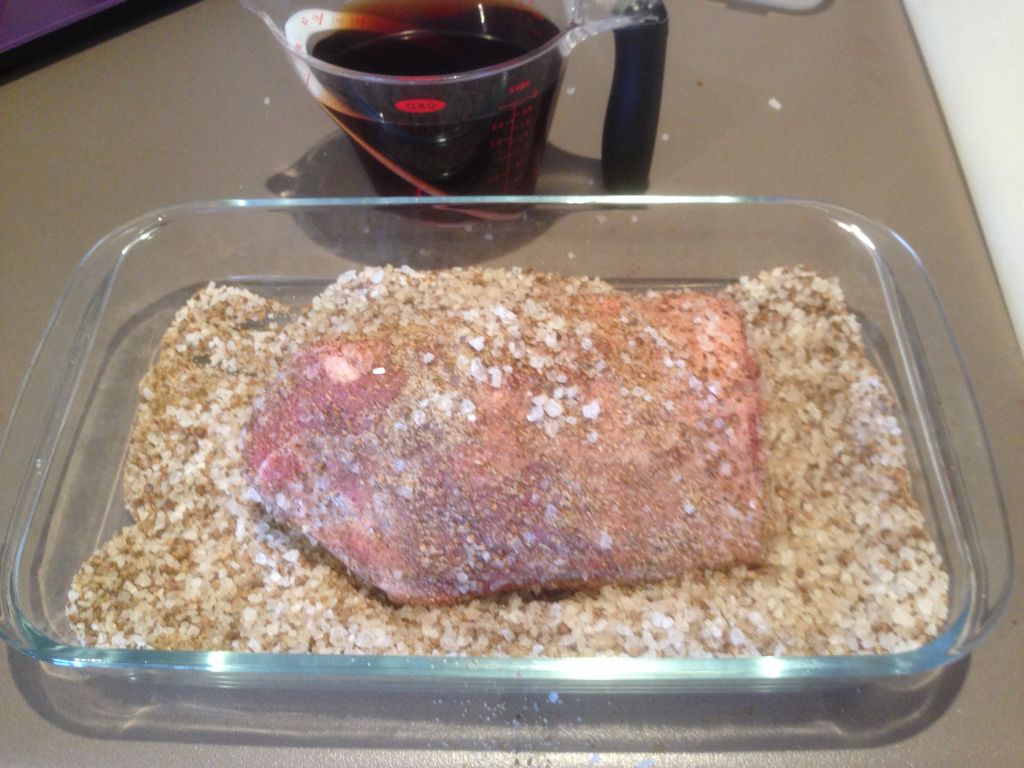
Into food container with vinegar and extra salt mix

Ready to dry
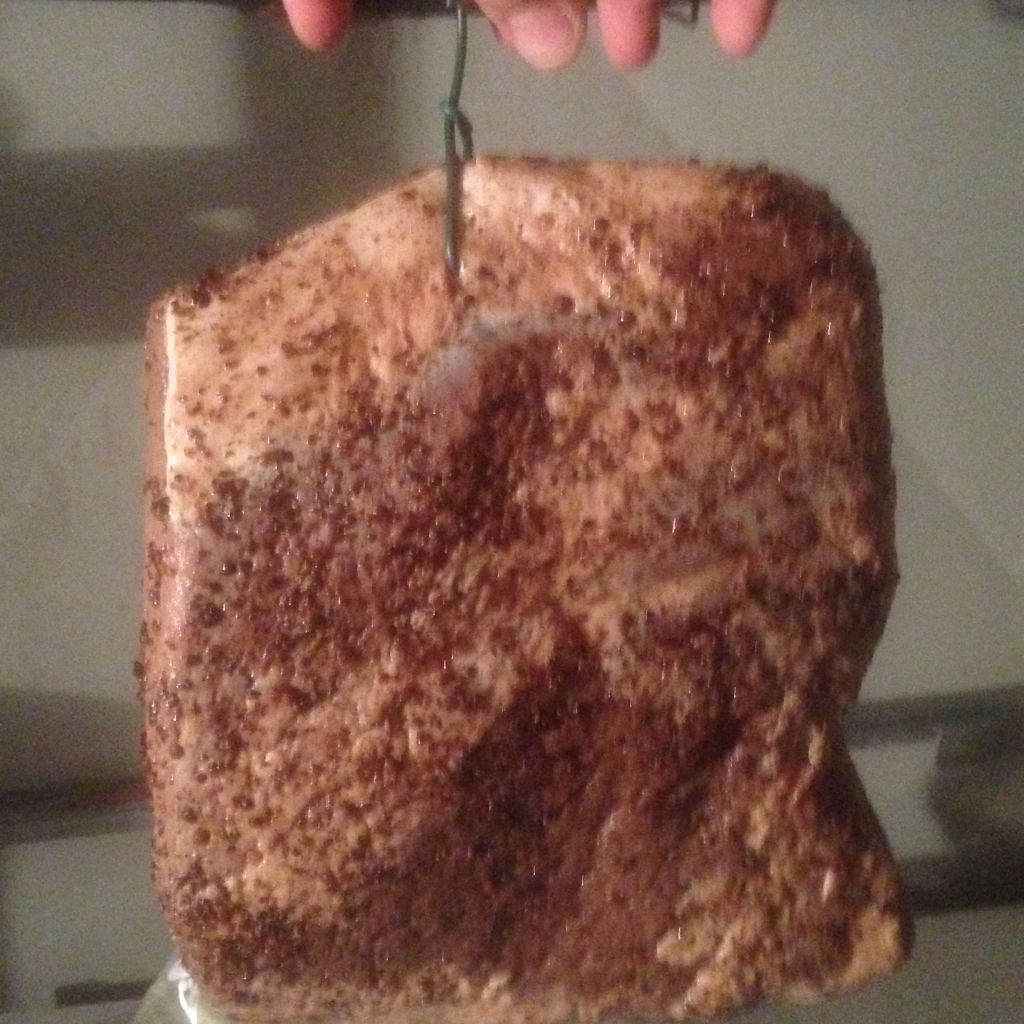
After five to six weeks
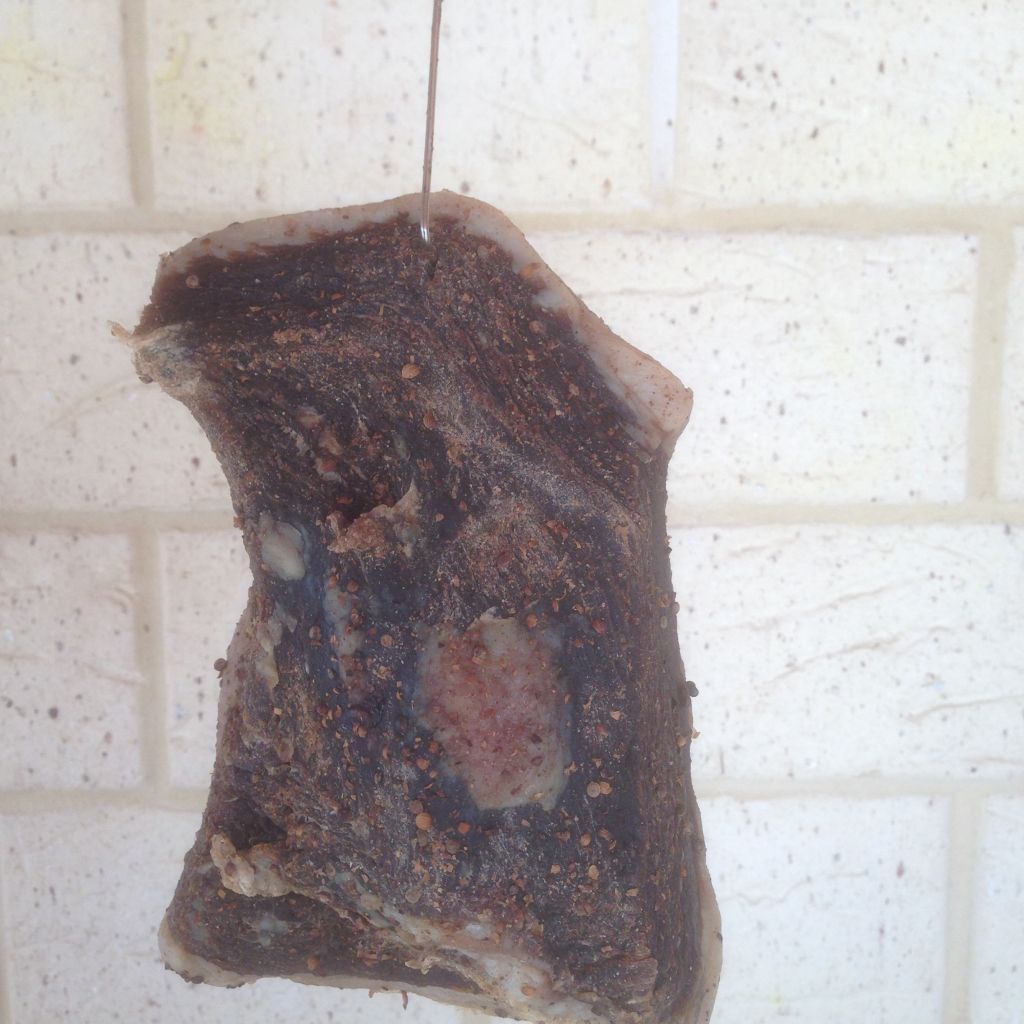
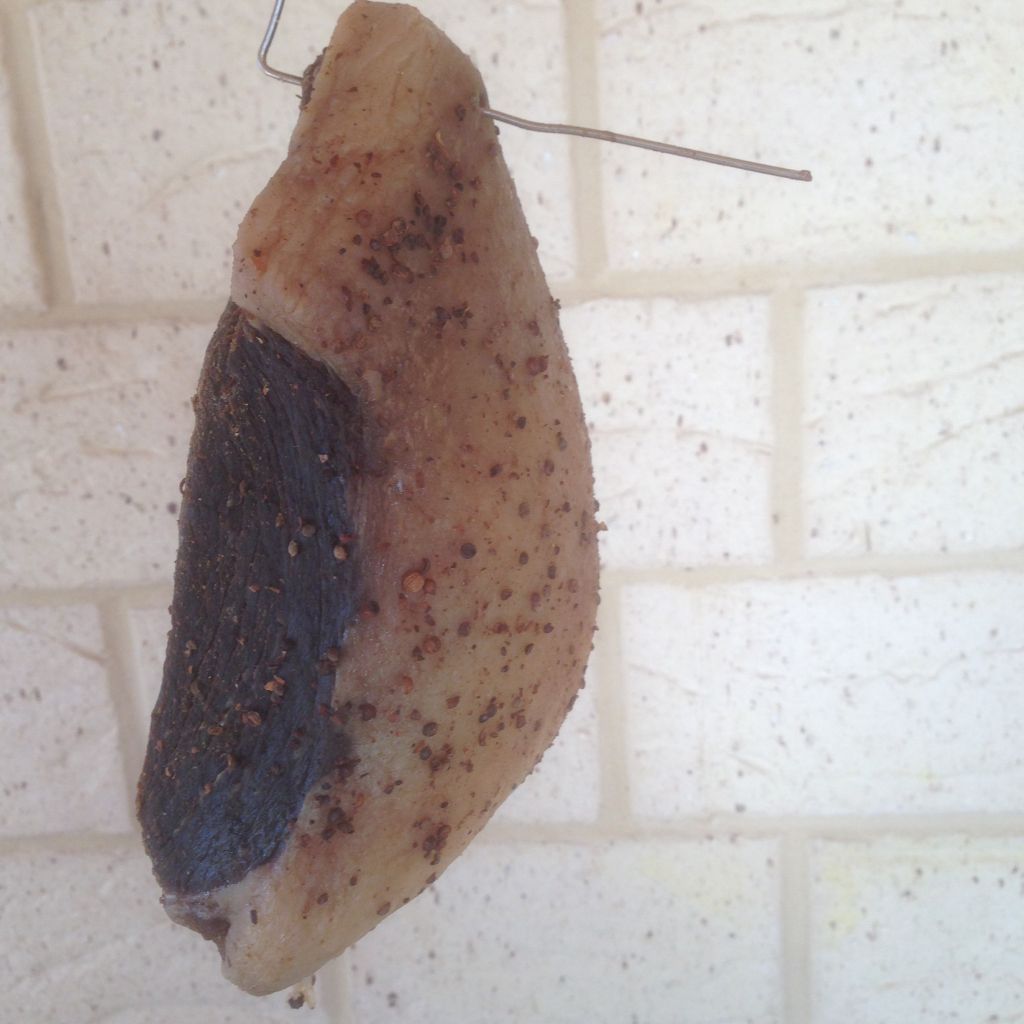
It can be eaten now...
Older, after some time in fridge, final product!
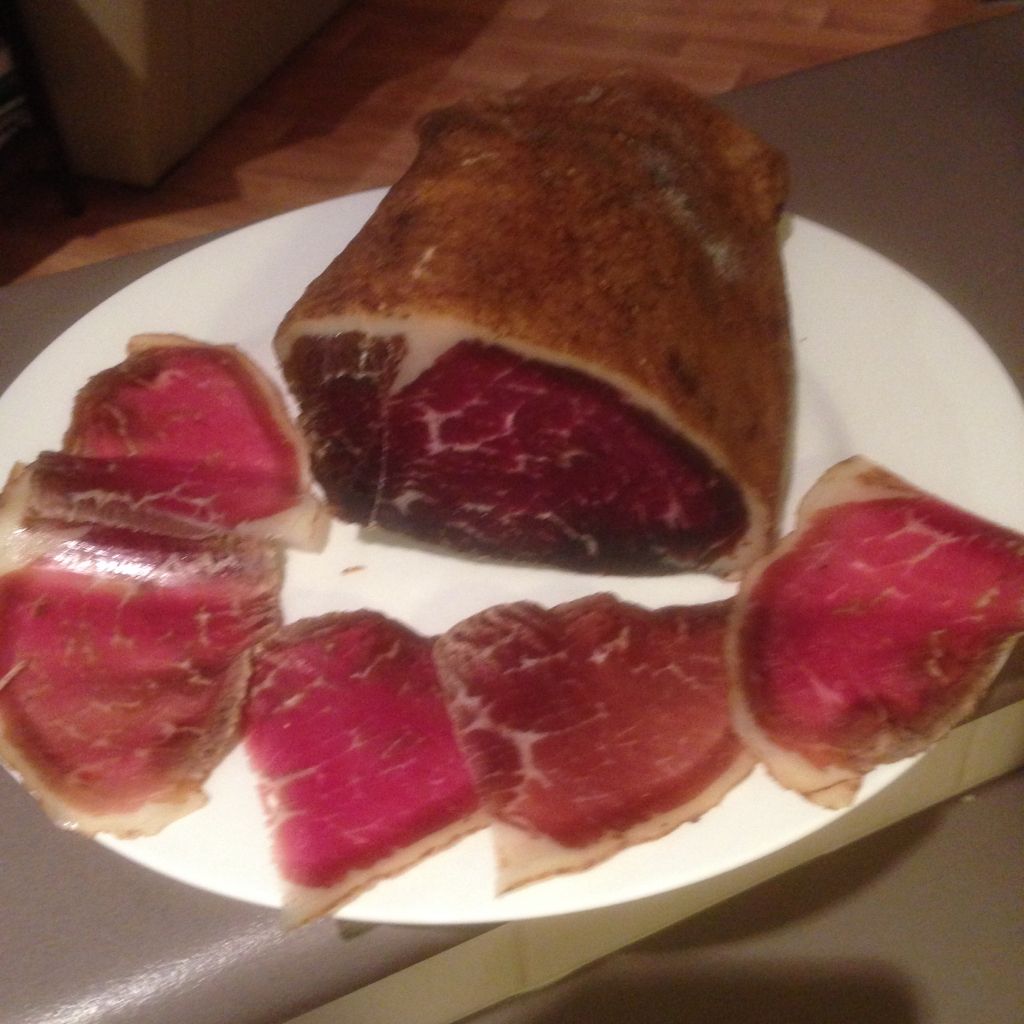
Posted: Mon Nov 03, 2014 14:12
by Janlab
Wow!,, it worked!
I'll write the recipe for the salt and spices next time.
Jan L
Btw, Willem was the first to do this, I copied him...
Posted: Mon Nov 03, 2014 14:22
by Janlab
If you are interested, I'll post my "high tech" biltongdryer in "Equipment"
J L
Posted: Mon Nov 03, 2014 14:40
by spud
Posted: Mon Nov 03, 2014 14:42
by spud
Holy mollie that happen to quick.
This is one my son presented for tasting, he called it Biltong as well.
cheers Spud

Posted: Mon Nov 03, 2014 15:48
by Janlab
It is biltong, just a different type! And I'd like to taste it!
When making thinner biltong, leave in brine not more than two hours.
Jan L
Posted: Mon Nov 03, 2014 21:38
by crustyo44
Hello Spud,
Your son's biltong look great. I usually slice mine paper thin so everybody plucks quite a few
between three fingers and start enjoying it.
Mind you, one windy day don't eat them on the patio or verandah.
What I have also done as a trial is that I dried the thinner pieces ( stokkies) until they were brittle and than chopped them up and reduced them in a kitchenwhizz to a course powder.
Sprinkled it over Spaghetti and also added it to meatballs.
If the biltong is smoked you are in for a treat believe me!!
Spud, I cut some of my biltong for about 15 mm thick to up to about 35 mm thick.
Depending on the cut of meat, mostly I use rump but shortly I will start using silverside flats trimmed of all its silverskin but not the fat cover.
Jan L,
Thanks for those photo's, your recipe quantities will be greatly appreciated.
Thanks,
Jan O.
Posted: Tue Nov 04, 2014 08:51
by redzed
Janlab and Spud, those pics of that biltong makes me wanna get some! I've had all kinds of things cross my table but never biltong! And thanks Janlab, for posting the recipe. I wonder whether it would be good made out of Canadian beef?

Posted: Tue Nov 04, 2014 12:43
by Janlab
Jan O,
Powdered biltong can also be bought in South Africa. The best usually comes from game, typically Impala, as it is very lean. As you say, it has to be tinder dry, and becomes a fluffy powder upon grinding. I have a small coffeegrinder just for that... Here I am going to use kangaroo or deer. Try it over scrambled eggs, and on pizza!
Recipe coming soon, first a bit of work!
Jan L
Posted: Tue Nov 04, 2014 15:47
by Janlab
Basic Biltong Recipe:
5 kg beef, silverside, rump or eye round. Cut into 25 - 30 mm strips with the grain. If you like your biltong soft ("wet") in the middle, you cut the strips thicker... You can trim or keep the fat, but it makes the biltong just better!
Cure;
500gr rocksalt, non iodised. (Never fine salt)
250 gr soft ( dark) brown sugar
2 tablespoons ground white pepper (easier than weight)
0.5 cup roasted (important!) coriander, ground coarsly
500 ml brown vinegar
(@ Red; you can work out a quantity of nitrate to be added, I don't know because I don't use it.)
Mix all dry stuff and place into a flat glas bowl.
Sprinkle vinager to wet the bottom of a large enough rectangular plastic or stainless steel container.
Roll each strip of meat in dry mix, and start packing into the container.
When the bottom is covered, sprinkle with vinager to wet all the strips.
Pack another layer and sprinkle.
Repeat until meat is finished, rationing the vinegar appropriately.
Cover and place in fridge for two to six hours depending on thickness of meat, and saltiness required. Be carefull not to make it too salty! Repack halfway through cure period swapping top and bottom strips.
At end of curing time, rinse all rocksalt from strips (important) with vinegar.
Hang in well ventilated cool place, or in my "high tech", or other biltongmaker, keeping air moving, until dry enough to taste. (Thin strips can be eaten as early as three days!). You want to get it "dry to touch" or ("wind dry", as we say) as quickly as possible.
Slice thin and enjoy! Fantastic on buttered full grain bread with sweet tea, or with cheese on biscuits, or just shove handfulls into your mouth! Or chew on a dry piece. Or grind a really dry lean piece and sprinkle over eggs, salad, pizza (typically with mild feta and avocado)
Variations:
Substitute half the vinegar with Worcestor Sauce.
Use other flavours of vinegar, ie cider vinegar, mulled vinegar, red wine vinegar, or even balsamic, but not white.
For more pepper, lightly dust strips with ground white pepper after rinsing, or roll in cracked black pepper.
For heat, roll in chilli flakes after rinsing.
For more coriander flavour, roll in coarsly ground toasted coriander after rinsing.
For garlic, sprinkle garlic flake over each layer before wetting with vinegar. Fresh finely chopped is nicer, but more difficult to distribute evenly
Use whatever other spice you like! As long as it marries with coriander.
For my "big biltong" I use the same proportions of salt and spice, but slightly more vingar, to cover the meat. But I use smaller containers. Also, I leave in the brine much longer, turning twice a day. I roll in coriander before hanging.
Jan L
Posted: Tue Nov 04, 2014 15:52
by Janlab
Red,
Canadian beef will do just fine, as will elk, moose, deer.... In South Africa, any kind of antelope meat is used, also Zebra and Cape Buffalo
Jan L







